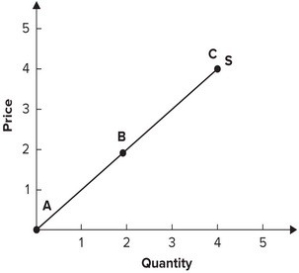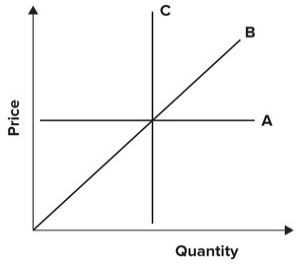A) 1
B) 4
C) .25
D) .5
Correct Answer

verified
Correct Answer
verified
Multiple Choice
College students tend to eat more ramen noodles than do recent college graduates. A primary reason for this is that:
A) ramen noodles are a normal good.
B) ramen noodles are an inferior good.
C) ramen noodles are a luxury good.
D) ramen noodles are scarce.
Correct Answer

verified
Correct Answer
verified
Multiple Choice
If the percentage increase in the quantity supplied equals the percentage increase in the price, the supply:
A) is elastic.
B) is inelastic.
C) has unit elasticity.
D) is perfectly elastic.
Correct Answer

verified
Correct Answer
verified
Multiple Choice
If the price elasticity of supply is 0.5, a 10 percent increase in price will cause a:
A) 5 percent increase in quantity supplied.
B) 5 percent decrease in quantity supplied.
C) 20 percent increase in quantity supplied.
D) 20 percent decrease in quantity supplied.
Correct Answer

verified
Correct Answer
verified
Multiple Choice
It is estimated that a 5 percent decline in income will reduce health care purchases by 2.5 percent and reduce dental service purchases by 8 percent. From this information, one can conclude that:
A) health care is a necessity and dental services are a luxury.
B) health care is a luxury and dental services are necessities.
C) both health care and dental services are necessities.
D) both health care and dental services are luxuries.
Correct Answer

verified
Correct Answer
verified
Multiple Choice
If the supply curve intersects the vertical (price) axis, the supply curve has an elasticity:
A) less than 1.
B) equal to 1.
C) greater than 1.
D) that is indeterminate.
Correct Answer

verified
Correct Answer
verified
Multiple Choice
The supply of Russian caviar from the Caspian Sea diminished after the collapse of Soviet communism. The price of caviar rose from $395 a pound to $595 a pound. Still, revenue from the sale of caviar rose 30 percent. You can conclude that:
A) an elastic supply curve for caviar has shifted to the left.
B) an inelastic supply curve for caviar has shifted to the left.
C) the supply curve for caviar has shifted to the left along an inelastic demand curve.
D) the supply curve for caviar has shifted to the left along an elastic demand curve.
Correct Answer

verified
Correct Answer
verified
Multiple Choice
If the supply of a product is inelastic, this implies that a specific percentage change in price leads to:
A) an equal percentage change in the quantity supplied.
B) a larger percentage change in the quantity supplied.
C) a smaller percentage change in the quantity supplied.
D) no percentage change in the quantity supplied.
Correct Answer

verified
C
Correct Answer
verified
Multiple Choice
An elasticity of supply of 2.7 means that:
A) supply is inelastic.
B) quantity supplied changes 2.7 units for each 1 percent change in price.
C) quantity supplied changes 2.7 percent for each 1 percent change in price.
D) price changes by 2.7 percent for each 1 percent change in quantity supplied.
Correct Answer

verified
Correct Answer
verified
Multiple Choice
Cross-price elasticity of demand is defined as the:
A) percentage change in quantity demanded divided by percentage change in the price of the same good.
B) percentage change in demand divided by percentage change in the price of another good.
C) change in the price of another good divided by the change in quantity demanded.
D) percentage change in the price of another good divided by the percentage change in quantity demanded.
Correct Answer

verified
Correct Answer
verified
Multiple Choice
For necessities, income elasticity is any value:
A) greater than 0.
B) greater than 1.
C) less than 0.
D) between 0 and 1.
Correct Answer

verified
Correct Answer
verified
Multiple Choice
Refer to the following graph.  Elasticity is greatest at point:
Elasticity is greatest at point:
A) A.
B) B.
C) C.
D) It is the same everywhere along this supply curve.
Correct Answer

verified
Correct Answer
verified
Multiple Choice
Refer to the following table to answer the question. Demand is most elastic between:
A) $2 and $4.
B) $4 and $6.
C) $6 and $8.
D) $8 and $10.
Correct Answer

verified
Correct Answer
verified
Multiple Choice
Refer to the graph shown. Which of the following curves demonstrates a perfectly inelastic demand curve? 
A) A
B) B
C) C
D) None of the curves
Correct Answer

verified
Correct Answer
verified
Multiple Choice
George Davis and Michael Wohlgenant estimate that for every 1 percent increase in the price of Christmas trees, quantity demanded falls by 0.6 percent. The demand for Christmas trees is:
A) inelastic.
B) elastic.
C) perfectly inelastic.
D) unit elastic.
Correct Answer

verified
Correct Answer
verified
Multiple Choice
Suppose the demand for butter increases from 800 to 1,000 pounds when income falls from $40,000 to 30,000. Income elasticity is:
A) 0.02.
B) 50.
C) -0.77.
D) 0.77.
Correct Answer

verified
Correct Answer
verified
Multiple Choice
As the manager of a ski resort, you want to increase the number of lift tickets sold by 8 percent. Your staff economist has determined that the price elasticity of demand for lift tickets is 2. To increase sales by the desired amount, you should decrease the price of a lift ticket by:
A) 2 percent.
B) 4 percent.
C) 8 percent.
D) 16 percent.
Correct Answer

verified
B
Correct Answer
verified
True/False
Price elasticity of demand is the percentage change in price divided by the percentage change in quantity demanded.
Correct Answer

verified
Correct Answer
verified
Multiple Choice
If frost in Florida reduces the quantity of vegetables sold by 20 percent and increases their retail price by 30 percent, one can conclude that:
A) the demand has shifted to the right along a perfectly inelastic supply curve.
B) the demand has shifted to the right along a perfectly elastic supply curve.
C) the supply of vegetables has shifted to the left along an elastic demand curve.
D) the supply of vegetables has shifted to the left along an inelastic demand curve.
Correct Answer

verified
Correct Answer
verified
Multiple Choice
As the price of tomatoes fell from $2.50 to $2.00, the quantity imported from Mexico fell from 1,800 tons to 900 tons. The elasticity of supply of tomatoes imported from Mexico is:
A) 0.25.
B) 0.3.
C) 3.0.
D) 5.
Correct Answer

verified
C
Correct Answer
verified
Showing 1 - 20 of 176
Related Exams